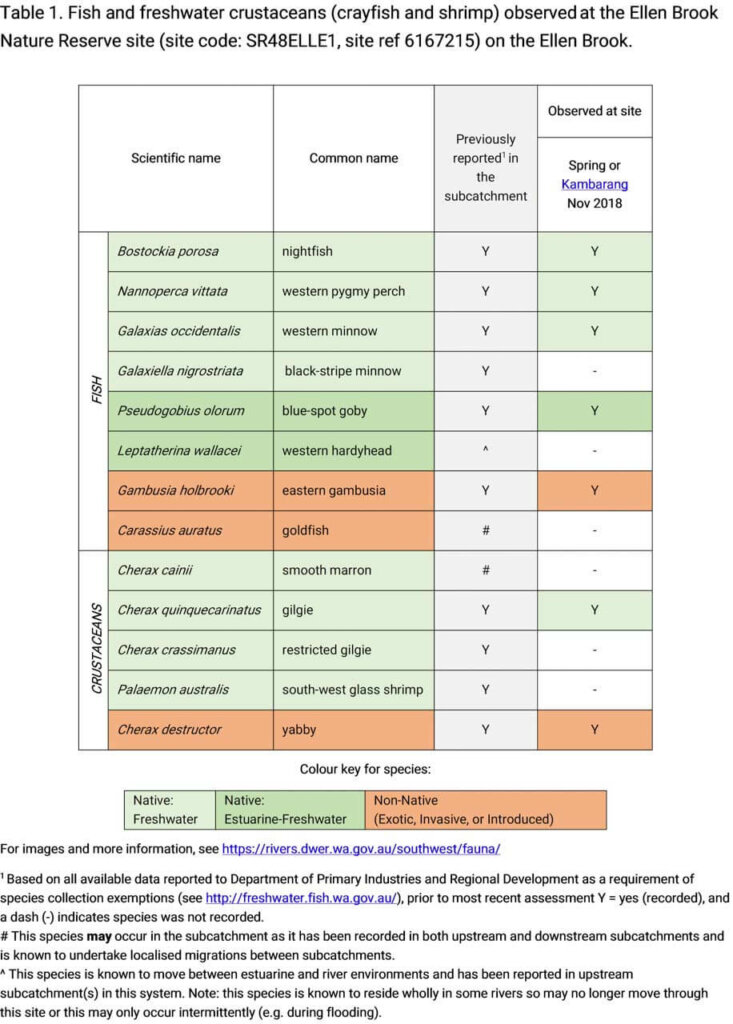Ellen Brook - Ellen Brook Nature Reserve
Basin : Swan-Coastal
Catchment : Swan-Avon River - Lower Swan River
River condition at the Ellen Brook Nature Reserve site (site code: SR249ELLE1, site reference: 6167215), in the lower Ellen Brook catchment was assessed as part of the Healthy Rivers Program (Healthy Rivers), using standard methods from the South West Index of River Condition (SWIRC).
Field data collected included the following indicators, assessed over about a 100 m length of stream:
- Aquatic biota: fish and crayfish community information (abundance of native and exotic species across size classes, general reproductive and physical condition)
- Water quality: dissolved oxygen, temperature, specific conductivity, and pH (logged in-situ over 24 hours) as well as laboratory samples for colour, alkalinity, turbidity and nutrients
- Aquatic habitat: e.g. water depth, substrate type, presence of woody debris and detritus, type and cover of macrophytes and draping vegetation
- Physical form: channel morphology, bank slope and shape, bioconnectivity (barriers to migration of aquatic species), erosion and sedimentation
- Fringing zone: width and length of vegetation cover within the river corridor and lands immediately adjacent, structural intactness of riparian and streamside vegetation
- Hydrology: measures of flow (velocity) at representative locations (compared against data from stream gauging stations within the system)
- Local land use: descriptions of local land use types and activities (compared against land use mapping information for the catchment)
Field data was collected between between 15 and 16 November 2018, and at this time no previous assessments of river ecology had been reported at this site.
Condition summary
A summary of aquatic biota detected over the different sampling events is provided in the section below. For other site data, please contact the department’s River Science team (please reference the site code and sampling dates).
Species found in subcatchment
Species found at the site
Fish and crayfish
As this was the first time this site had been sampled using SWIRC methods, the species expected to occur here (listed below) are based on species reported from studies conducted elsewhere in the catchment. As differences in habitat within a reach naturally influence species distributions, and variability in methods between sampling programs can affect the species caught, so this list is only indicative.
5 fish species (4 native and 1 exotic) and 2 crayfish (1 native and 1 exotic) were found at this site in 2018, see Table 1, below, for details.
Click here for full size table.
Only fish and freshwater crustaceans (crayfish and shrimp) that typically inhabit river channels are targeted by the standard SWIRC sampling methods.
Note: collection of fauna from WA’s inland aquatic ecosystems requires a license from the Department of Primary Industries and Regional Development (DPIRD) and also the Department of Biodiversity, Conservation and Attractions (DBCA). All species collected must be reported to these agencies as part of license conditions.
Other aquatic fauna
The south-western snake-necked turtle (Chelodina colliei) was also found at this site.
Frogs and tadpoles along with insects in aquatic stages of their life cycle and leeches were observed at the site.
Explore other sites in the catchment
- Bassendean Main Drain Industrial
- Bassendean Main Drain Residential
- Bennett Brook - Downstream of Mussel Pool
- Blackadder Creek - Muriel Street Downstream
- Cookes Brook - Old Coach Road East
- Ellen Brook - Brand Highway downstream
- Ellen Brook - Millhouse Road Bridge
- Helena River - Mundaring Weir Downstream
- Helena River - Whiteman Road
- Jane Brook - De Grey Retreat
- Jane Brook - Sexton Street
- South Belmont Main Drain
- Susannah Brook - Reserve No 50069
- Woodbridge Creek
- Wooroloo Brook - Karls Ranch
- Yalyal Brook
